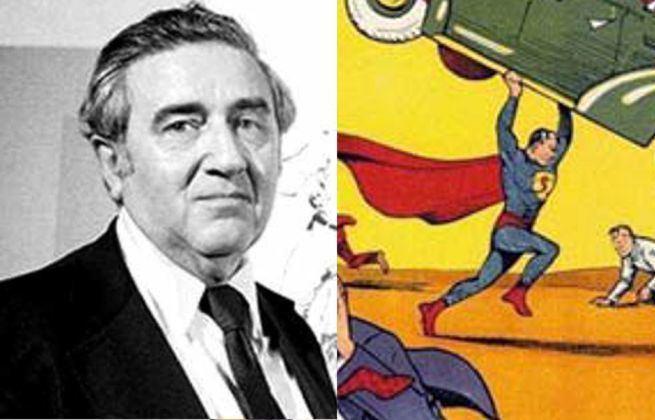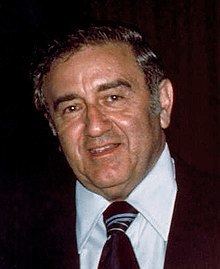Nationality American Area(s) Writer | Name Jerry Siegel Role Comic Book Creator | |
 | ||
Born Jerome SiegelOctober 17, 1914Cleveland, Ohio, US ( 1914-10-17 ) Pseudonym(s) Joe Carter, Jerry Ess, Herbert S. Fine Notable works Superman, Action Comics #1 Awards Inkpot Award, 1975Will Eisner Comic Book Hall of Fame, 1992Jack Kirby Hall of Fame, 1993The Bill Finger Award For Excellence in Comic Book Writing, 2005 Spouse Joanne Siegel (m. 1948–1996), Bella Siegel (m. 1939–1948) Books Superman: The Golden Age Omnibus Vol. 1 Children Laura Siegel, Michael Siegel Movies and TV shows Man of Steel, Superman, Superman Returns, Batman v Superman: Dawn of J, Adventures of Superman Similar People Joe Shuster, Bob Kane, Bill Finger, Wayne Boring, Curt Swan Died January 28, 1996 (aged 81) Los Angeles, California, U.S. | ||
Superman the comic strip hero 1 of 5
Jerome "Jerry" Siegel (; October 17, 1914 – January 28, 1996), who also used pseudonyms including Joe Carter, and Jerry Ess, was the American co-creator, along with Joe Shuster, of Superman, the first of the great comic book superheroes and one of the most recognizable of the 20th century.
Contents
- Superman the comic strip hero 1 of 5
- A interview with jerry siegel creator of superman
- Early life
- Superman and following years
- Awards and honors
- Siegel Shuster v Warner Communications
- Siegel estate v Time Warner
- Superboy lawsuit
- Personal life
- References

He was inducted (with Shuster posthumously) into the comic book industry's Will Eisner Comic Book Hall of Fame in 1992 and the Jack Kirby Hall of Fame in 1993.

A interview with jerry siegel creator of superman
Early life
Siegel was born in Cleveland, Ohio, the youngest of six children of Jewish immigrants from the Russian Empire, a part which later became Lithuania, Sarah (née Fine) and Mitchell Siegel (né Mikhel Segalovich). He was preceded by sisters Minerva and Roslyn, both in Lithuania, brothers Harry and Leo, and sister Isabel. His father was a sign painter who opened a haberdashery and encouraged his son's artistic inclinations. Mitchell died of a heart attack brought on by the robbery of his store, when Jerry was in junior high school. Siegel was a fan of movies, comic strips, and especially science fiction pulp magazines. He became active in a fandom, corresponding with other science fiction fans, including the young future author Jack Williamson. In 1929, Siegel published what might have been the first SF fanzine, Cosmic Stories, which he produced with a manual typewriter and advertised in the classified section of Science Wonder Stories. He published several other booklets over the next few years.
Siegel attended Glenville High School in Cleveland, Ohio and worked for its weekly student newspaper, The Torch. He was a shy, not particularly popular student, but he achieved a bit of fame among his peers for his popular Tarzan parody, "Goober the Mighty." At about age 16, while at Glenville, he befriended his later collaborator, Joe Shuster. Siegel described his friendship with the similarly shy and bespectacled Shuster: "When Joe and I first met, it was like the right chemicals coming together."
The writer-artist team broke into comics with Major Malcolm Wheeler-Nicholson's landmark New Fun, debuting with the musketeer swashbuckler "Henri Duval" and the supernatural-crimefighter strip Doctor Occult in issue #6 (Oct. 1935).
Superman and following years
Siegel and Shuster created a bald telepathic villain referred to as "the Superman", bent on dominating the entire world. He appeared in the short story "The Reign of the Superman" from Science Fiction #3, a science fiction fanzine that Siegel published in 1933. Tossing and turning in bed one night in 1934, he thought of the more familiar character by that name. Siegel and Shuster then began a four-year quest to find a publisher. Titling it The Superman, Siegel and Shuster offered it to Consolidated Book Publishing, who had published a 48-page black-and-white comic book entitled Detective Dan: Secret Operative No. 48. Although the duo received an encouraging letter, Consolidated never again published comic books. Shuster took this to heart and burned all pages of the story, the cover surviving only because Siegel rescued it from the fire. Siegel and Shuster each compared this character to Slam Bradley, an adventurer the pair had created for Detective Comics #1 (March 1937). In 1938, after that proposal had languished among others at More Fun Comics—published by National Allied Publications, the primary precursor of DC Comics—editor Vin Sullivan chose it as the cover feature for National's Action Comics #1 (June 1938). The following year, Siegel & Shuster initiated the syndicated Superman comic strip. Siegel also created the ghostly avenger The Spectre during this same period.
As part of the deal which saw Superman published in Action Comics, Siegel and Shuster sold the rights to the company in return for $130 and a contract to supply the publisher with material.
Siegel and Shuster's status as children of Jewish immigrants is also thought to have influenced their work. One scholar has argued that they crafted "an immigrant figure whose desire was to fit into American culture as an American", something that taps into an important aspect of American identity.
In 1946, Siegel and Shuster, nearing the end of their 10-year contract to produce Superman stories, sued National over rights to the characters. In 1947, the team had rejoined editor Sullivan, by now the founder and publisher of the comic-book company Magazine Enterprises; there they created the short-lived comical crime-fighter Funnyman. Siegel went on to become comics art director for publisher Ziff-Davis in the early 1950s, and later returned to DC to write uncredited Superman stories in 1959 under the control of Silver Age Superman editor Mort Weisinger. When he sued DC over the Superman rights again in 1967, his relationship with the hero he had co-created was again severed.
Siegel's later work would appear in Marvel Comics, where under the pseudonym "Joe Carter" he scripted the "Human Torch" feature in Strange Tales #112–113 (Sept.-Oct. 1963), introducing the teenaged Torch's high school girlfriend, Doris Evans; and, under his own name, a backup feature starring the X-Men member Angel, which ran in Marvel Tales and Ka-Zar. Siegel wrote as well during this time for Archie Comics, where he created campy versions of existing superheroes in Archie's Mighty Comics line; Charlton Comics, where he created a few superheroes; and even England's Lion, where he scripted The Spider. In 1968, he worked for Western Publishing, for which he wrote (along with Carl Barks) stories in the Junior Woodchucks comic book. In the 1970s, he worked for Mondadori Editore (at that time the Italian Disney comic book licensee) on its title Topolino, listed in the mastheads of the period as a scriptwriter ("soggettista e sceneggiatore").
In the 1980s, he worked with Val Mayerik on his new comic called The Starling, which appeared in the pages of Destroyer Duck. Around this time, he also wrote some comics for Aardvark-Vanaheim.
In 1985, DC Comics named Siegel as one of the honorees in the company's 50th anniversary publication Fifty Who Made DC Great. Siegel was invited in 1986 by DC Comics' editor Julius Schwartz to write an "imaginary" final story for Superman, following Marv Wolfman's Crisis on Infinite Earths limited series and before John Byrne's The Man of Steel miniseries, which reintroduced Superman. Siegel declined, and the story was instead given to writer Alan Moore, and published in September 1986 in two parts entitled "Whatever Happened to the Man of Tomorrow?" published in Superman #423 and Action Comics #583.
Awards and honors
Siegel & Shuster v. Warner Communications
Siegel in 1975 launched a public-relations campaign to protest DC Comics' treatment of Shuster and himself. Ultimately, Warner Communications, DC's parent company, awarded Siegel and Shuster $20,000 a year, later increased to $30,000, each for the rest of their lives and guaranteed that all comics, TV episodes, films, and, later, video games starring Superman would be required to carry the credit that Superman was "created by Jerry Siegel and Joe Shuster." The first issue with the restored credit was Superman #302 (August 1976).
Siegel estate v. Time Warner
On April 16, 1999, Siegel's widow Joanne Siegel, and their daughter, Laura Siegel Larson, filed a copyright termination notice. Warner Bros. contested this copyright termination, making the status of Siegel's share of the copyright the subject of a legal battle. Warner Bros. and the Siegels entered into discussions on how to resolve the issues raised by the termination notice. DC made a settlement offer to Larson and her family on October 16, 2001, and three days later, DC received a letter from Larson’s attorney accepting the offer, which included millions of dollars in payment in exchange for the copyrights. This offer was set aside by the Siegels at the last minute and in October 2004 they filed suit alleging copyright infringement on the part of Warner Bros. Warner Bros. countersued, alleging, among other arguments, that the termination notice contains defects. On March 26, 2008, Judge Stephen G. Larson of the Federal District Court for the Central District of California ruled that Siegel's estate was entitled to claim a share in the United States copyright. The ruling does not affect the international rights which Time Warner holds in the character through its subsidiary DC Comics. Issues regarding the amount of monies owed Siegel's estate and whether the claim the estate has extends to derivative works such as movie versions will be settled at trial, although any compensation would only be owed from works published since 1999. The case was scheduled to be heard in a California federal court in May 2008.
Both the Siegel estate and Time Warner have appealed Larson's ruling. The Siegel estate claims the judge erred by finding most of the Superman material written by Siegel from 1938 through 1943 to be work for hire. Time Warner asserts the Siegel estate had agreed to a settlement that precludes termination, and that the material awarded to the Siegel estate by Judge Larson was actually work for hire. Oral argument was held on November 5, 2012, in the United States Court of Appeals for the Ninth Circuit. In January 2013, the Ninth Circuit reversed the 2008 decision, since the October 2001 agreement would have settled the dispute, and ruled the 2001 agreement would be followed.
Superboy lawsuit
Superboy was the subject of a legal battle between Time Warner, the owner of DC Comics and the estate of Jerry Siegel. The Siegels argued that Jerry Siegel was an independent contractor at the time he proposed the original character, which DC declined at the time. After returning from World War II, Siegel found that DC had published a Superboy story which bore similarities to his proposal.
On March 23, 2006, federal judge Ronald S. W. Lew issued a summary judgment ruling that the Siegel heirs had the right to revoke their copyright assignment to Superboy and had successfully reclaimed the rights as of November 17, 2004. Warner Bros. and DC Comics replied that they "respectfully disagree" with the ruling and would seek review. Warner Bros. and DC Comics filed a motion for reconsideration of Judge Lew's ruling in January 2007. On July 27, 2007, federal judge Larson (who had replaced Lew upon his taking "senior status") reversed Judge Lew's ruling that the Siegel heirs had reclaimed the rights to Superboy.
Personal life
Siegel was married twice. He married Bella (d. 2002), an 18-year-old Glenville High graduate, in 1939, and they had a son, Michael (1944-January 17, 2006). Siegel saw little of his son after divorcing Bella in 1948, following years of estrangement from her. He married Joanne Carter later that year, and they had a daughter together, Laura Siegel.
